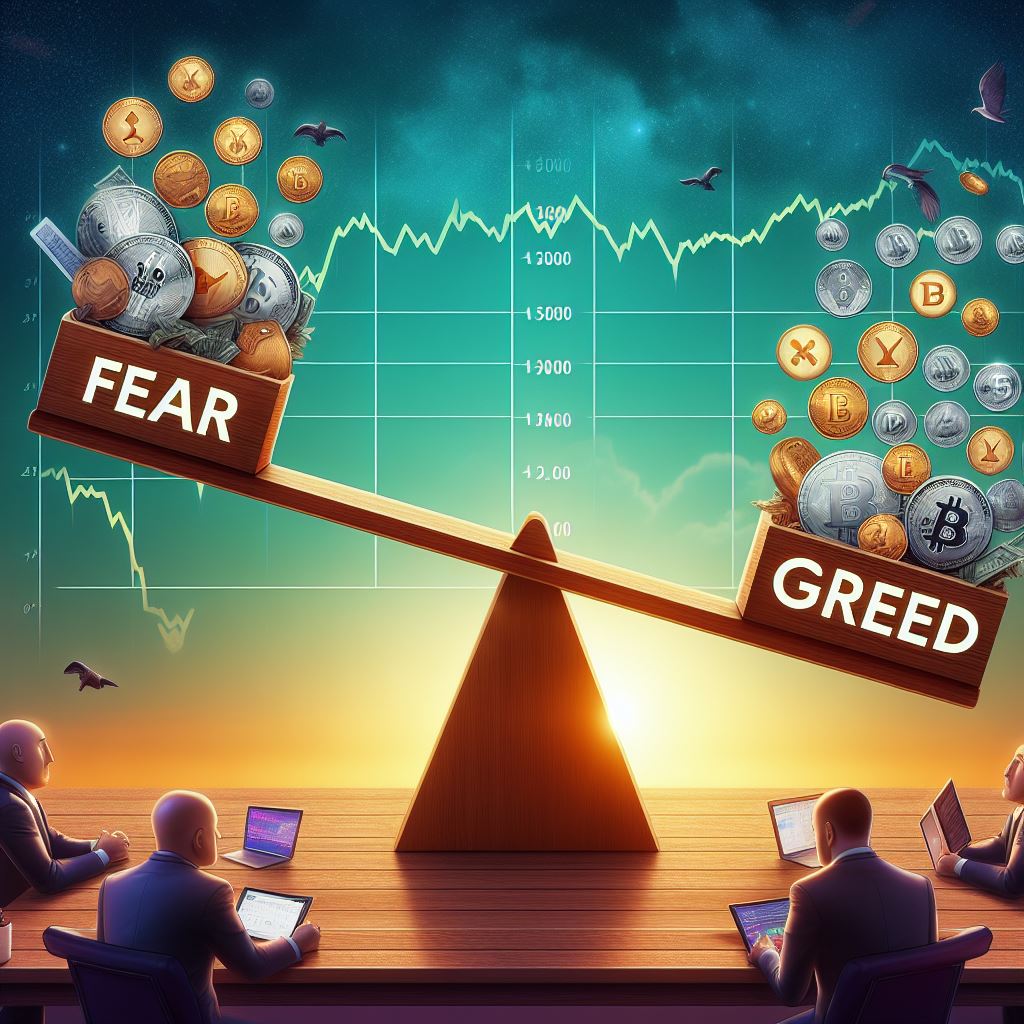Key Takeaways:
- The Fear and Greed Index is a tool that measures the prevailing emotions in the crypto market, ranging from extreme fear to extreme greed.
- The index analyzes various data points, including volatility, market momentum, social media sentiment, and trading volume, to determine the current market sentiment.
- Crypto traders and investors can use the Fear and Greed Index to make more informed decisions, such as buying during periods of fear or taking profits during periods of greed.
- While the index can be a useful tool, it should not be relied upon as the sole basis for investment decisions and should be used in conjunction with other market analysis techniques.
1. Introduction
Emotions play a significant role in the decision-making process of traders and investors, particularly in the highly volatile world of cryptocurrencies. To help market participants gauge the prevailing sentiment in the crypto space, the Fear and Greed Index has emerged as a popular tool. This index provides a quantitative measure of the emotions driving the market, ranging from extreme fear to extreme greed.
In this comprehensive guide, we’ll explore the Fear and Greed Index in depth, discussing its components, calculation methodology, and how it can be used by crypto traders and investors to make more informed decisions. We’ll also examine the limitations of the index and provide tips on how to incorporate it into a broader market analysis strategy.
1.1. What is the Fear and Greed Index?
The Fear and Greed Index is a tool that measures the dominant emotions influencing the cryptocurrency market at a given time. The index was created by Alternative.me, a fintech company that specializes in developing tools and insights for the crypto industry. The index assigns a value between 0 and 100 to the current market sentiment, with 0 representing extreme fear and 100 representing extreme greed.
The Fear and Greed Index is based on the idea that excessive fear can lead to undervalued asset prices, while excessive greed can lead to overvalued prices. By measuring these emotions, the index aims to help traders and investors identify potential buying or selling opportunities and make more informed decisions.
1.2. Why Emotions Matter in Crypto Markets
Cryptocurrencies are known for their high volatility, with prices often experiencing significant fluctuations in short periods. This volatility can be attributed, in part, to the emotional nature of market participants. When the market is rallying, traders and investors may experience a fear of missing out (FOMO), leading to increased buying pressure and further price appreciation. Conversely, during market downturns, panic selling can exacerbate price declines as market participants rush to exit their positions.
Emotions can cloud judgment and lead to irrational decision-making, causing traders and investors to deviate from their planned strategies. By understanding the prevailing market sentiment, as measured by the Fear and Greed Index, market participants can potentially mitigate the impact of emotions on their decisions and take advantage of opportunities created by the emotional reactions of others.
1.3. The Historical Performance of the Fear and Greed Index
Since its inception, the Fear and Greed Index has demonstrated a strong correlation with the price movements of major cryptocurrencies, particularly Bitcoin. During periods of extreme fear, as indicated by low values on the index, Bitcoin prices have often experienced significant declines. Conversely, periods of extreme greed have typically coincided with Bitcoin price rallies.
For example, during the 2017 bull run, the Fear and Greed Index consistently displayed high values, indicating extreme greed in the market. This sentiment was reflected in the parabolic rise of Bitcoin prices, which ultimately peaked at nearly $20,000 in December 2017. Following the subsequent market correction, the index plummeted to values below 10, signaling extreme fear as prices retreated.
While the Fear and Greed Index is not a predictive tool, its historical performance suggests that it can provide valuable insights into the emotional state of the market and potentially help traders and investors make more informed decisions.
2. Components of the Fear and Greed Index
The Fear and Greed Index is calculated using a combination of five weighted factors that aim to capture the emotional state of the cryptocurrency market. These factors include volatility, market momentum, social media sentiment, dominance, and trading volume.
2.1. Volatility
Volatility is a measure of the price fluctuations of cryptocurrencies over a given period. The Fear and Greed Index considers the current volatility of Bitcoin and compares it to the average values over the past 30 and 90 days. Higher volatility is typically associated with more fearful market conditions, while lower volatility is associated with more stable or greedy market sentiment.
The volatility component of the index is calculated using the following formula:
Volatility = (Average 30-day Volatility + Average 90-day Volatility) / 2
The volatility data is sourced from BitStamp, one of the oldest and most reputable cryptocurrency exchanges.
2.2. Market Momentum
Market momentum measures the rate of change in the price of cryptocurrencies over a specified period. The Fear and Greed Index considers the current momentum of Bitcoin and compares it to the average values over the past 30 and 90 days. Positive momentum, or prices rising at an increasing rate, is associated with greed, while negative momentum, or prices falling at an increasing rate, is associated with fear.
The market momentum component of the index is calculated using the following formula:
Momentum = (Current Momentum - Average 30-day Momentum) / (Average 30-day Momentum - Average 90-day Momentum)The momentum data is sourced from CoinMarketCap, a leading provider of cryptocurrency market data and analytics.
2.3. Social Media Sentiment
Social media sentiment analyzes the overall tone and volume of conversations related to cryptocurrencies on popular social media platforms, such as Twitter and Reddit. The Fear and Greed Index uses natural language processing algorithms to determine the ratio of positive to negative mentions of Bitcoin and other cryptocurrencies.
Higher levels of positive sentiment are associated with greed, while higher levels of negative sentiment are associated with fear. The social media sentiment component of the index is calculated using a proprietary algorithm developed by Alternative.me.
2.4. Dominance
Dominance refers to the market capitalization share of Bitcoin relative to the total market capitalization of all cryptocurrencies. The Fear and Greed Index considers the current Bitcoin dominance and compares it to the average values over the past 30 and 90 days.
A rising Bitcoin dominance is typically associated with a more fearful market sentiment, as investors may be moving funds from altcoins to the perceived safety of Bitcoin. Conversely, a declining Bitcoin dominance may indicate a more greedy sentiment, as investors become more willing to take risks on altcoins.
The dominance component of the index is calculated using the following formula:
Dominance = (Current Bitcoin Dominance - Average 30-day Bitcoin Dominance) / (Average 30-day Bitcoin Dominance - Average 90-day Bitcoin Dominance)The dominance data is sourced from CoinMarketCap.
2.5. Trading Volume
Trading volume measures the total value of cryptocurrencies traded across major exchanges over a specified period. The Fear and Greed Index considers the current trading volume and compares it to the average values over the past 30 and 90 days.
Higher trading volumes are typically associated with more greedy market sentiment, as they may indicate increased participation and interest in the market. Lower trading volumes, on the other hand, may suggest a more fearful sentiment, as traders become less active.
The trading volume component of the index is calculated using the following formula:
Trading Volume = (Current Trading Volume - Average 30-day Trading Volume) / (Average 30-day Trading Volume - Average 90-day Trading Volume)The trading volume data is sourced from CoinMarketCap and includes volume from major cryptocurrency exchanges.
3. Interpreting the Fear and Greed Index
The Fear and Greed Index provides a quantitative measure of the prevailing market sentiment, with values ranging from 0 to 100. Understanding how to interpret these values can help traders and investors make more informed decisions based on the emotional state of the market.
3.1. Index Value Ranges
The Fear and Greed Index is divided into five main ranges, each representing a different level of market sentiment:
- Extreme Fear (0-24): This range indicates a highly pessimistic market sentiment, often characterized by panic selling and significant price declines. Extreme fear may present potential buying opportunities for long-term investors, as assets may be undervalued.
- Fear (25-49): This range suggests a moderately negative market sentiment, with traders and investors exhibiting caution and risk aversion. Prices may continue to decline, but the rate of decline may be slower compared to periods of extreme fear.
- Neutral (50): A value of 50 indicates a balanced market sentiment, with neither fear nor greed dominating. Prices may be relatively stable, and traders and investors may be more focused on fundamental factors rather than emotional responses.
- Greed (51-74): This range suggests a moderately positive market sentiment, with traders and investors becoming more optimistic and willing to take on additional risk. Prices may continue to rise, but the rate of increase may be slower compared to periods of extreme greed.
- Extreme Greed (75-100): This range indicates a highly optimistic market sentiment, often characterized by FOMO (fear of missing out) and speculation. Extreme greed may present potential selling opportunities, as assets may be overvalued and due for a correction.
3.2. Using the Fear and Greed Index in Trading and Investing
Crypto traders and investors can use the Fear and Greed Index to inform their decision-making process and potentially improve their market timing. Some strategies that incorporate the index include:
- Contrarian Investing: Contrarian investors seek to buy assets when others are fearful and sell when others are greedy. By monitoring the Fear and Greed Index, contrarian investors can identify potential entry and exit points based on the prevailing market sentiment.
- Risk Management: The index can help traders and investors gauge the overall risk in the market. During periods of extreme fear or greed, traders may consider reducing their position sizes or implementing tighter stop-losses to manage risk.
- Trend Confirmation: The Fear and Greed Index can be used in conjunction with other technical analysis tools to confirm market trends. For example, if the index is showing extreme greed during a bullish trend, it may suggest that the trend is likely to continue in the short term.
- Sentiment Analysis: By comparing the current index value to historical values, traders and investors can assess whether the market sentiment is aligned with past trends. This can help identify potential sentiment shifts and market turning points.
It’s important to note that the Fear and Greed Index should not be used as the sole basis for trading or investing decisions. Instead, it should be considered as one of many tools in a comprehensive market analysis strategy.
3.3. Limitations of the Fear and Greed Index
While the Fear and Greed Index can be a useful tool for gauging market sentiment, it has some limitations that traders and investors should be aware of:
- Short-Term Focus: The index is designed to measure short-term sentiment and may not reflect longer-term market trends or fundamental factors.
- Lagging Indicator: The Fear and Greed Index is a lagging indicator, meaning it reflects sentiment based on past market data. As such, it may not always accurately predict future market movements.
- Bitcoin-Centric: The index is primarily focused on Bitcoin and may not fully capture the sentiment in the broader cryptocurrency market, particularly for altcoins.
- Limited Data Sources: The index relies on a limited number of data sources, which may not provide a complete picture of market sentiment.
Despite these limitations, the Fear and Greed Index remains a popular and valuable tool for many crypto traders and investors, offering insights into the emotional state of the market.
4. Historical Analysis of the Fear and Greed Index
Examining the historical performance of the Fear and Greed Index can provide valuable insights into how market sentiment has influenced cryptocurrency prices in the past. By understanding these patterns, traders and investors can potentially improve their market timing and decision-making.
4.1. The 2017 Bull Run
The 2017 bull run was a period of unprecedented growth in the cryptocurrency market, with Bitcoin and many altcoins experiencing massive price appreciation. During this time, the Fear and Greed Index consistently displayed high values, indicating extreme greed in the market.
For example, in December 2017, when Bitcoin reached its then all-time high of nearly $20,000, the Fear and Greed Index was at a value of 95, suggesting that market participants were overwhelmingly optimistic and driven by FOMO. This extreme greed was followed by a sharp correction in early 2018, with Bitcoin prices falling by over 60% in the subsequent months.
4.2. The 2018-2019 Bear Market
Following the 2017 bull run, the cryptocurrency market entered a prolonged bear market, characterized by significant price declines and a general sense of pessimism among market participants. During this period, the Fear and Greed Index consistently displayed low values, indicating extreme fear in the market.
In December 2018, when Bitcoin prices reached a low of around $3,200, the Fear and Greed Index was at a value of 10, suggesting that market participants were highly fearful and risk-averse. This period of extreme fear was followed by a gradual recovery in 2019, with Bitcoin prices eventually reaching a high of around $13,000 in June of that year.
4.3. The COVID-19 Crash and Recovery
The COVID-19 pandemic had a significant impact on global financial markets, including cryptocurrencies. In March 2020, as the severity of the pandemic became apparent, the Fear and Greed Index plummeted to a value of 8, indicating extreme fear in the market.
This extreme fear coincided with a sharp decline in Bitcoin prices, which fell from around $9,000 to a low of around $4,000 in a matter of days. However, the market quickly recovered, with the Fear and Greed Index rising to a value of 56 (neutral) by the end of April 2020.
4.4. The 2021 Bull Market
The cryptocurrency market experienced another significant bull run in 2021, with Bitcoin and many altcoins reaching new all-time highs. During this period, the Fear and Greed Index consistently displayed high values, indicating extreme greed in the market.
In February 2021, when Bitcoin prices reached a new all-time high of around $58,000, the Fear and Greed Index was at a value of 92, suggesting that market participants were highly optimistic and driven by FOMO. This period of extreme greed was followed by a correction in May 2021, with Bitcoin prices falling by over 50% in the subsequent weeks.
These historical examples demonstrate how the Fear and Greed Index has captured the prevailing market sentiment during significant price movements in the cryptocurrency market. By monitoring the index and comparing current values to historical patterns, traders and investors can potentially improve their understanding of market dynamics and make more informed decisions.
5. Conclusion
The Fear and Greed Index has emerged as a valuable tool for crypto traders and investors seeking to understand the emotional state of the market. By quantifying the prevailing sentiment, the index can help market participants make more informed decisions and potentially improve their market timing.
Throughout this guide, we’ve explored the components of the Fear and Greed Index, including volatility, market momentum, social media sentiment, dominance, and trading volume. We’ve also discussed how to interpret the index values and incorporate them into trading and investing strategies.
Additionally, we’ve examined the historical performance of the index, highlighting its relationship with significant market events, such as the 2017 bull run, the 2018-2019 bear market, the COVID-19 crash, and the 2021 bull market. By understanding these historical patterns, traders and investors can potentially gain valuable insights into how market sentiment influences cryptocurrency prices.
However, it’s essential to recognize the limitations of the Fear and Greed Index and use it as part of a comprehensive market analysis approach. The index should be considered alongside other technical, fundamental, and sentiment analysis tools to form a well-rounded understanding of market conditions.
As the cryptocurrency market continues to evolve and mature, tools like the Fear and Greed Index will likely remain valuable for traders and investors seeking to navigate the complex and often emotional world of digital assets. By staying informed, disciplined, and adaptable, market participants can potentially improve their decision-making and long-term success in the cryptocurrency space.
Frequently Asked Questions (FAQs)
1. What is the Fear and Greed Index, and how does it work?
The Fear and Greed Index is a tool that measures the prevailing emotions in the cryptocurrency market, ranging from extreme fear to extreme greed. It analyzes various data points, including volatility, market momentum, social media sentiment, dominance, and trading volume, to determine the current market sentiment and assigns a value between 0 (extreme fear) and 100 (extreme greed).
2. How can crypto traders and investors use the Fear and Greed Index?
Crypto traders and investors can use the Fear and Greed Index to:
- Make more informed decisions based on market sentiment
- Identify potential buying opportunities during periods of extreme fear
- Consider taking profits or reducing exposure during periods of extreme greed
- Confirm market trends in conjunction with other technical analysis tools
- Assess the overall risk in the market and adjust their risk management strategies accordingly
4. What are the components of the Fear and Greed Index?
The Fear and Greed Index is calculated using five weighted factors:
- Volatility: Measures the price fluctuations of cryptocurrencies over a given period
- Market Momentum: Measures the rate of change in cryptocurrency prices
- Social Media Sentiment: Analyzes the tone and volume of conversations related to cryptocurrencies on social media platforms
- Dominance: Measures the market capitalization share of Bitcoin relative to the total market capitalization of all cryptocurrencies
- Trading Volume: Measures the total value of cryptocurrencies traded across major exchanges
5. What do the different index value ranges represent?
The Fear and Greed Index is divided into five main ranges:
- Extreme Fear (0-24): Highly pessimistic market sentiment, potential buying opportunities
- Fear (25-49): Moderately negative market sentiment, traders and investors exhibiting caution
- Neutral (50): Balanced market sentiment, neither fear nor greed dominating
- Greed (51-74): Moderately positive market sentiment, traders and investors becoming more optimistic
- Extreme Greed (75-100): Highly optimistic market sentiment, potential selling opportunities
6. How often is the Fear and Greed Index updated?
The Fear and Greed Index is updated daily, providing a near-real-time assessment of market sentiment.
7. What are some limitations of the Fear and Greed Index?
Some limitations of the Fear and Greed Index include:
- Short-term focus: The index measures short-term sentiment and may not reflect longer-term trends
- Lagging indicator: The index is based on past market data and may not always accurately predict future movements
- Bitcoin-centric: The index primarily focuses on Bitcoin and may not fully capture sentiment in the broader cryptocurrency market
- Limited data sources: The index relies on a limited number of data sources, which may not provide a complete picture of market sentiment
8. Should traders and investors rely solely on the Fear and Greed Index for making decisions?
No, traders and investors should not rely solely on the Fear and Greed Index for making decisions. The index should be used as part of a comprehensive market analysis approach, alongside other technical, fundamental, and sentiment analysis tools.
9. How has the Fear and Greed Index performed during significant market events?
The Fear and Greed Index has captured the prevailing market sentiment during significant price movements in the cryptocurrency market, such as:
- The 2017 Bull Run: Consistently displayed high values, indicating extreme greed
- The 2018-2019 Bear Market: Consistently displayed low values, indicating extreme fear
- The COVID-19 Crash and Recovery: Plummeted to extreme fear during the crash, then recovered to neutral sentiment
- The 2021 Bull Market: Consistently displayed high values, indicating extreme greed








